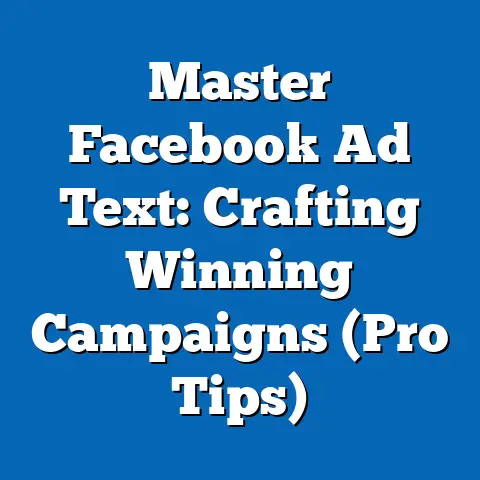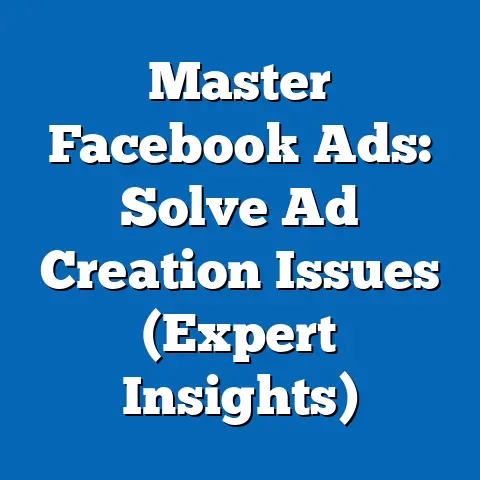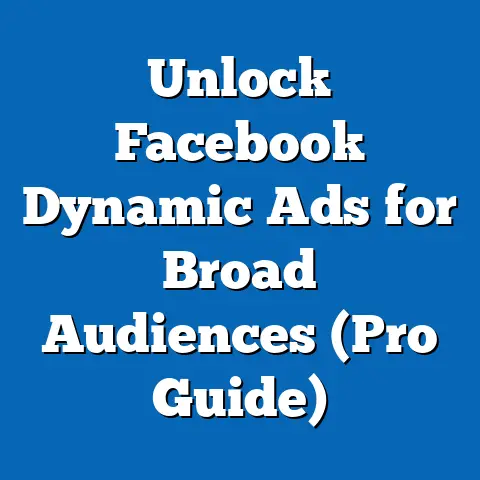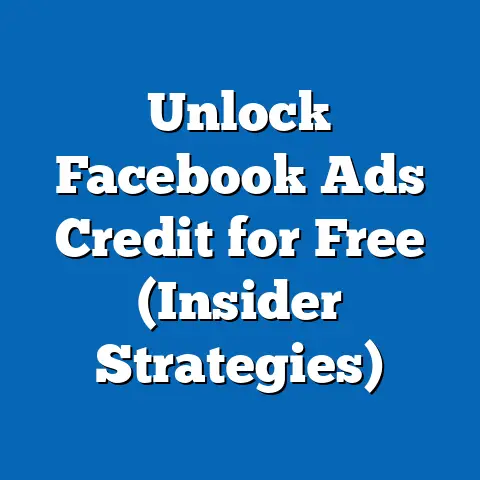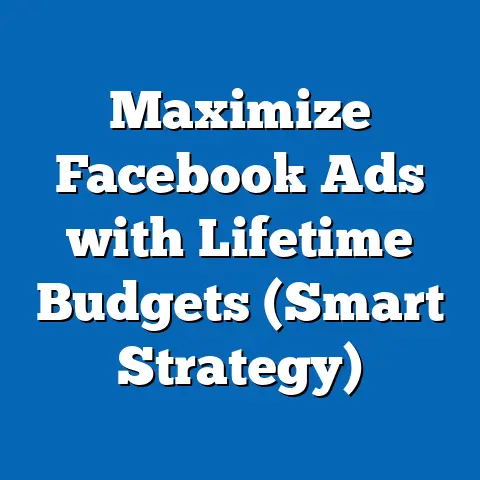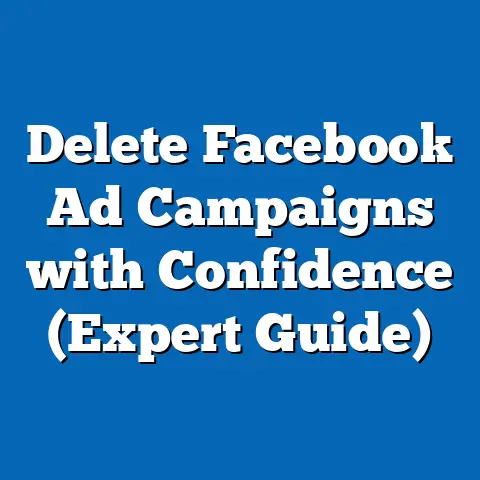Unlock All Facebook Sponsored Ads (Insider Techniques)
Remember the days when Facebook was just a platform to connect with friends, share vacation photos, and post status updates? I do! Back then, the idea of businesses heavily relying on it for advertising seemed like a distant future. But fast forward to today, and it’s a powerhouse for businesses looking to reach their audience through targeted advertising. Have you ever wondered how some brands seem to have mastered Facebook sponsored ads while others struggle to gain traction? I certainly did, and that curiosity led me down a rabbit hole of experimentation, learning, and ultimately, success.
In this article, I’m going to pull back the curtain and share the insider techniques I’ve learned over the years to unlock the full potential of Facebook sponsored ads. Whether you’re a seasoned marketer or just starting out, these strategies will help you navigate the ever-evolving landscape of Facebook advertising and achieve the results you’ve been dreaming of.
The Evolution of Facebook Advertising
It’s easy to forget that Facebook advertising wasn’t always the sophisticated beast it is today. Back in the early days, it was pretty basic. Banner ads and simple text-based promotions were the norm. I remember when the biggest innovation was being able to target ads based on age and location!
Over the years, Facebook ads have gone through a massive transformation. The introduction of features like News Feed ads, custom audiences, and the Facebook Pixel revolutionized the way businesses approached online advertising. These changes allowed for more personalized and targeted campaigns, leading to higher engagement and conversion rates.
The growth of Facebook as an advertising platform is staggering. From a humble beginning, it has grown into a multi-billion dollar industry, attracting businesses of all sizes. According to Statista, Facebook’s advertising revenue continues to climb, demonstrating its effectiveness as a marketing channel. This growth highlights the importance of mastering Facebook ads for business success. If you’re not leveraging Facebook ads effectively, you’re missing out on a huge opportunity to reach your target audience and grow your business.
Compared to traditional advertising methods like TV, radio, or print, Facebook ads offer unparalleled targeting capabilities and cost-effectiveness. With traditional advertising, you’re essentially casting a wide net and hoping to catch a few fish. But with Facebook ads, you can laser-target your ideal customers based on demographics, interests, behaviors, and more. This means you’re only spending money on reaching people who are most likely to be interested in your products or services.
Key Takeaway: Facebook advertising has evolved from basic banner ads to a sophisticated, data-driven platform. Understanding this evolution is crucial for leveraging its full potential.
Understanding the Facebook Ad Ecosystem
The Facebook ad ecosystem is a complex web of interconnected components, each playing a vital role in the success of your campaigns. Let’s break it down:
-
Ads Manager: This is your central hub for creating, managing, and analyzing your Facebook ad campaigns. I spend a significant amount of time in Ads Manager, tweaking settings, monitoring performance, and experimenting with new strategies. It’s where you define your target audience, set your budget, choose your ad placements, and track your results.
-
Ad Formats: Facebook offers a variety of ad formats to suit different marketing objectives and target audiences. Some of the most popular formats include:
- Carousel Ads: These allow you to showcase multiple products or services in a single ad, each with its own image, headline, and link. I’ve found carousel ads to be particularly effective for e-commerce businesses.
- Video Ads: Video ads are highly engaging and can be used to tell a story, demonstrate a product, or simply capture attention. I always recommend experimenting with video ads, as they often outperform static image ads.
- Slideshow Ads: These are a cost-effective alternative to video ads, allowing you to create a visually appealing slideshow using a series of images or videos.
- Collection Ads: Designed for mobile shoppers, collection ads allow you to showcase a selection of products in a visually appealing format.
-
Targeting Options: Facebook’s targeting options are incredibly granular, allowing you to reach your ideal customers with precision. You can target people based on demographics (age, gender, location), interests (hobbies, passions, activities), behaviors (purchase history, online activity), and more. I’ve spent hours experimenting with different targeting combinations to find the sweet spot for my campaigns.
-
Facebook Pixel: The Facebook Pixel is a small piece of code that you install on your website to track user behavior and measure the effectiveness of your ad campaigns. It allows you to track conversions, retarget website visitors, and optimize your ads for better performance. I consider the Facebook Pixel to be an essential tool for any serious Facebook advertiser.
Ads Manager: This is your central hub for creating, managing, and analyzing your Facebook ad campaigns. I spend a significant amount of time in Ads Manager, tweaking settings, monitoring performance, and experimenting with new strategies. It’s where you define your target audience, set your budget, choose your ad placements, and track your results.
Ad Formats: Facebook offers a variety of ad formats to suit different marketing objectives and target audiences. Some of the most popular formats include:
- Carousel Ads: These allow you to showcase multiple products or services in a single ad, each with its own image, headline, and link. I’ve found carousel ads to be particularly effective for e-commerce businesses.
- Video Ads: Video ads are highly engaging and can be used to tell a story, demonstrate a product, or simply capture attention. I always recommend experimenting with video ads, as they often outperform static image ads.
- Slideshow Ads: These are a cost-effective alternative to video ads, allowing you to create a visually appealing slideshow using a series of images or videos.
- Collection Ads: Designed for mobile shoppers, collection ads allow you to showcase a selection of products in a visually appealing format.
Targeting Options: Facebook’s targeting options are incredibly granular, allowing you to reach your ideal customers with precision. You can target people based on demographics (age, gender, location), interests (hobbies, passions, activities), behaviors (purchase history, online activity), and more. I’ve spent hours experimenting with different targeting combinations to find the sweet spot for my campaigns.
Facebook Pixel: The Facebook Pixel is a small piece of code that you install on your website to track user behavior and measure the effectiveness of your ad campaigns. It allows you to track conversions, retarget website visitors, and optimize your ads for better performance. I consider the Facebook Pixel to be an essential tool for any serious Facebook advertiser.
Understanding your audience is paramount to success on Facebook. Facebook’s data allows for precise targeting, ensuring your ads are seen by the right people. I’ve found that the more specific you can get with your targeting, the better your results will be. Don’t be afraid to experiment with different targeting options to find what works best for your business.
Key Takeaway: The Facebook ad ecosystem is complex but powerful. Understanding its components and how they work together is essential for creating successful campaigns.
Insider Techniques for Successful Facebook Ads
Now, let’s dive into the heart of the matter: the insider techniques that can take your Facebook ads from mediocre to magnificent.
A/B Testing: The Key to Optimization
A/B testing, also known as split testing, is the process of comparing two versions of an ad to see which one performs better. I can’t stress enough how important A/B testing is for optimizing your Facebook ad campaigns. It’s the only way to know for sure what resonates with your target audience.
Here are some examples of what to test:
- Ad Creatives: Try different images, videos, or slideshows to see which ones capture attention and generate the most clicks.
- Headlines: Experiment with different headlines to see which ones are most compelling and persuasive.
- Ad Copy: Test different ad copy variations to see which ones resonate with your target audience and drive conversions.
- Targeting Options: Try different targeting combinations to see which ones are most effective at reaching your ideal customers.
- Call-to-Actions (CTAs): Test different CTAs to see which ones encourage people to take the desired action, such as “Learn More,” “Shop Now,” or “Sign Up.”
When conducting A/B tests, it’s important to only change one variable at a time. This allows you to isolate the impact of each variable and determine what’s working and what’s not. I typically run A/B tests for at least a week to gather enough data to make statistically significant conclusions.
Key Takeaway: A/B testing is essential for optimizing your Facebook ad campaigns. Test different ad creatives, headlines, ad copy, targeting options, and CTAs to see what resonates with your target audience.
Targeting Strategies: Beyond the Basics
Facebook’s targeting options are incredibly powerful, but many advertisers only scratch the surface. Here are some advanced targeting techniques that I’ve found to be particularly effective:
- Lookalike Audiences: Lookalike audiences allow you to reach new people who are similar to your existing customers. You can create lookalike audiences based on your website visitors, email list, or Facebook page fans. I’ve used lookalike audiences to significantly expand my reach and acquire new customers.
- Retargeting Past Website Visitors: Retargeting allows you to show ads to people who have previously visited your website. This is a highly effective strategy because these people have already shown an interest in your products or services. I’ve found that retargeting ads often have higher conversion rates than other types of ads.
- Custom Audiences: Custom audiences allow you to upload your own data, such as email lists or phone numbers, and target those people with your ads. This is a great way to reach your existing customers with special offers or promotions.
When creating custom audiences, it’s important to comply with Facebook’s privacy policies and ensure that you have the necessary permissions to use the data.
Key Takeaway: Go beyond basic targeting options and leverage lookalike audiences, retargeting, and custom audiences to reach your ideal customers with precision.
Compelling Ad Copy and Visuals: Capturing Attention
In today’s crowded digital landscape, it’s more important than ever to create ad copy and visuals that capture attention and resonate with your target audience. Here are some insider tips:
- Use High-Quality Images and Videos: Your visuals are the first thing people will see, so make sure they’re visually appealing and relevant to your offer. I always invest in professional-quality images and videos to ensure that my ads stand out from the crowd.
- Write Persuasive Ad Copy: Your ad copy should be clear, concise, and persuasive. Highlight the benefits of your product or service and tell people what you want them to do. I use a copywriting formula called AIDA (Attention, Interest, Desire, Action) to craft compelling ad copy.
- Use Strong Headlines: Your headline is the first thing people will read, so make sure it’s attention-grabbing and relevant to your offer. I try to use headlines that are both informative and intriguing.
- Speak to Your Target Audience: Use language that resonates with your target audience and addresses their specific needs and pain points. I always research my target audience thoroughly before writing any ad copy.
- Test Different Ad Variations: As mentioned earlier, A/B testing is essential for optimizing your ad copy and visuals. Test different variations to see what resonates with your target audience.
Key Takeaway: Create eye-catching visuals and persuasive ad copy that resonates with your target audience. Use high-quality images and videos, write clear and concise ad copy, and speak to your target audience’s specific needs and pain points.
Utilizing Video Ads: The Power of Motion
Video ads tend to perform better in terms of engagement because they are more visually appealing and can convey more information in a shorter amount of time. According to studies, video ads have higher click-through rates (CTR) and conversion rates than static image ads.
Here are some tips for creating effective video ads:
- Keep it Short and Sweet: People have short attention spans, so keep your video ads short and to the point. I aim for videos that are 15-30 seconds long.
- Grab Attention Quickly: Your video should grab attention in the first few seconds. Use an attention-grabbing visual or a compelling hook to keep people watching. I often start my videos with a question or a surprising statement.
- Tell a Story: Use your video to tell a story that resonates with your target audience. Stories are more engaging and memorable than simple product demonstrations.
- Show, Don’t Tell: Instead of simply telling people about your product or service, show them how it works and what it can do for them.
- Include a Clear Call-to-Action: Tell people what you want them to do after watching your video. Include a clear call-to-action, such as “Shop Now,” “Learn More,” or “Sign Up.”
Key Takeaway: Video ads are highly engaging and can be used to tell a story, demonstrate a product, or simply capture attention. Keep your videos short and sweet, grab attention quickly, and include a clear call-to-action.
Optimizing for Conversions: Turning Clicks into Customers
Setting clear objectives for your campaigns is crucial for measuring success and optimizing for better ROI. Before you launch any Facebook ad campaign, ask yourself: What do I want to achieve with this campaign? Do I want to generate leads, drive sales, increase brand awareness, or something else?
Once you’ve defined your objectives, you can leverage Facebook’s optimization tools to improve your ROI. Here are some tips:
- Use Conversion Tracking: Conversion tracking allows you to track the actions that people take on your website after clicking on your ad. This data can be used to optimize your ads for better performance.
- Optimize for Conversions: Facebook allows you to optimize your ads for specific conversion events, such as purchases, leads, or sign-ups. This tells Facebook to show your ads to people who are most likely to take the desired action.
- Use Dynamic Ads: Dynamic ads automatically show the most relevant products to each individual user based on their past browsing behavior. This is a highly effective strategy for e-commerce businesses.
- Retarget Abandoned Carts: Retarget people who have added items to their shopping cart but haven’t completed the purchase. Offer them a discount or free shipping to encourage them to complete the transaction.
Key Takeaway: Set clear objectives for your campaigns and leverage Facebook’s optimization tools to improve your ROI. Use conversion tracking, optimize for conversions, and retarget abandoned carts.
Analyzing and Adjusting Campaigns
Data analysis is crucial for refining your ad strategies and maximizing your ROI. I’m constantly monitoring my Facebook ad campaigns, looking for trends and insights that can inform future ad decisions.
Here are the key metrics that I monitor:
- Click-Through Rate (CTR): This is the percentage of people who click on your ad after seeing it. A high CTR indicates that your ad is relevant and engaging to your target audience.
- Cost Per Click (CPC): This is the average cost you pay each time someone clicks on your ad. A low CPC indicates that your ads are efficient and cost-effective.
- Conversion Rate: This is the percentage of people who take the desired action (e.g., purchase, lead, sign-up) after clicking on your ad. A high conversion rate indicates that your website or landing page is effective at converting visitors into customers.
- Cost Per Acquisition (CPA): This is the average cost you pay to acquire a new customer. A low CPA indicates that your ads are efficient and cost-effective at generating new customers.
- Return on Ad Spend (ROAS): This is the amount of revenue you generate for every dollar you spend on advertising. A high ROAS indicates that your ads are profitable and generating a good return on investment.
I use Facebook Insights to track these metrics and identify areas for improvement. Facebook Insights provides a wealth of data about your ad campaigns, including demographics, interests, and behaviors of the people who are clicking on your ads. I use this data to refine my targeting, ad copy, and visuals.
Based on the data, I make data-driven adjustments to my campaigns. For example, if I see that my CTR is low, I might try testing different headlines or ad copy. If I see that my CPA is high, I might try refining my targeting or optimizing my landing page.
Key Takeaway: Data analysis is crucial for refining your ad strategies. Monitor key metrics, such as CTR, CPC, conversion rate, CPA, and ROAS, and use Facebook Insights to make data-driven adjustments to your campaigns.
Navigating Challenges in Facebook Advertising
Facebook advertising is not without its challenges. Here are some common challenges that advertisers face and insider techniques to overcome them:
- Ad Fatigue: Ad fatigue occurs when your target audience starts to see your ads too often and becomes desensitized to them. To overcome ad fatigue, I regularly refresh my ad creatives, headlines, and ad copy. I also try rotating my targeting options to reach new people.
- Competition: The Facebook advertising landscape is highly competitive, with businesses of all sizes vying for attention. To stand out from the competition, I focus on creating high-quality, engaging ads that resonate with my target audience. I also try to offer unique value propositions that differentiate my business from the competition.
- Changing Algorithms and Policies: Facebook’s algorithms and policies are constantly changing, which can make it difficult to stay ahead of the curve. To stay updated, I regularly read industry blogs, attend webinars, and follow Facebook’s official announcements. I also try to be proactive and adapt my strategies as needed.
Staying compliant with Facebook’s advertising policies is essential for avoiding penalties, such as ad disapprovals or account suspensions. I always make sure to review Facebook’s advertising policies before launching any new campaign.
Key Takeaway: Be aware of common challenges, such as ad fatigue, competition, and changing algorithms and policies, and use insider techniques to overcome them. Stay updated with Facebook’s changing algorithms and policies and ensure compliance.
Conclusion
Mastering Facebook sponsored ads is an ongoing process that requires experimentation, learning, and adaptation. By implementing the insider techniques I’ve shared in this article, you’ll be well on your way to unlocking the full potential of Facebook advertising and achieving the results you’ve been dreaming of.
Remember, the key is to be data-driven, creative, and persistent. Don’t be afraid to experiment with different strategies and see what works best for your business. And always stay updated with the latest trends and best practices in Facebook advertising.
So, what are you waiting for? It’s time to take action and start unlocking the power of Facebook sponsored ads!

